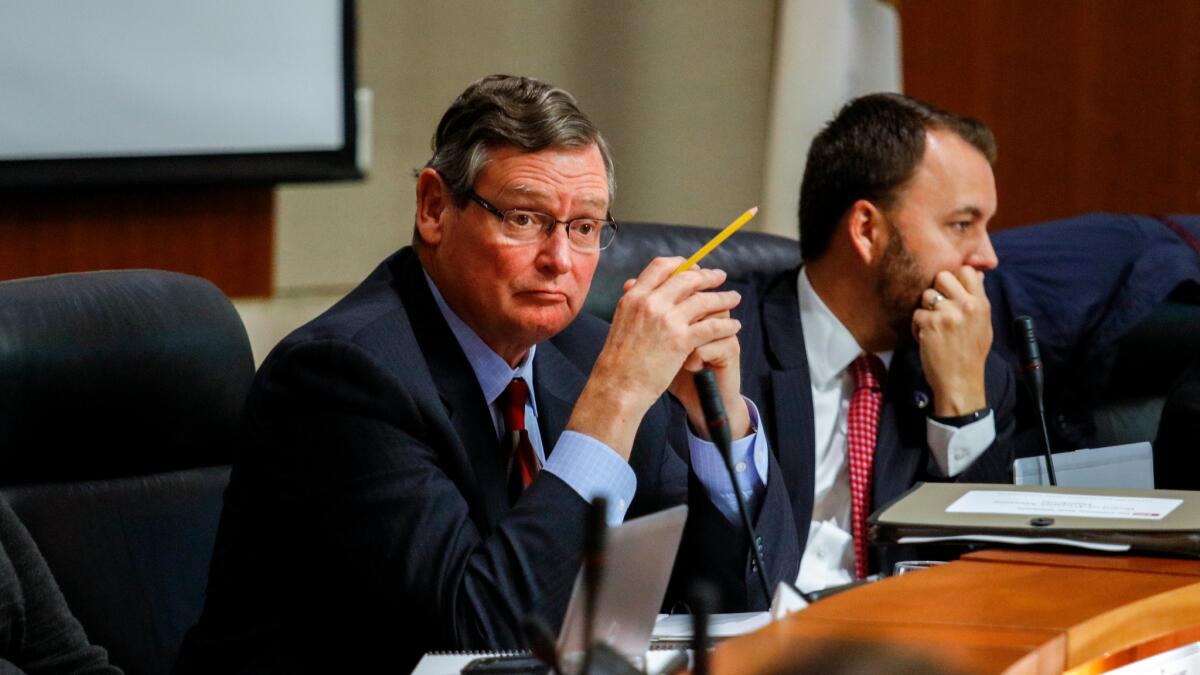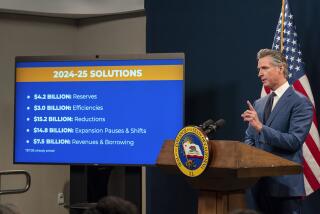Cal State students rally in protest across California as trustees debate increasing tuition

In a lively discussion that ran almost an hour longer than scheduled, California State University’s Board of Trustees debated the controversial possibility of increasing tuition as a way to fill a looming gap in state funding.
They made it clear that they’d hoped Gov. Jerry Brown’s budget proposal would provide what was necessary to preserve the quality of the nation’s largest public university system. Instead, the amount he allocated in additional state funding is less than half what Cal State requested.
Hugo Morales was one of numerous trustees who peppered university officials with detailed questions about possible alternatives and financial aid for low-income students.
He received applause from more than two dozen students and faculty members at the meeting in Long Beach when he said that he found it unsettling to consider passing on the shortfall in state funding to students.
Hanging over the debate was the University of California regents’ 16 to 4 vote last week to end their six-year freeze on tuition — and approve a 2.5%, or $282, increase next school year — because of a similar funding bind.
At Cal State, Chancellor Timothy P. White has proposed an increase of about 5%, which could amount to as much as $270 for in-state students. Tuition for out-of-state students as well as graduate and teacher credential programs would also see increases.
The tuition increases, White said, would generate $77.5 million in crucial net revenue. The more than 60% of Cal State students whose tuition is fully covered by grants and waivers would not be affected.
The trustees won’t vote on the proposed increase until March. Even then, they agreed to reconsider if necessary after the governor’s budget is set in June. University officials have launched a website, www.calstate.edu/tuition-increase, for students and families to review the details and share their concerns, which will be presented to the trustees in March.
On Tuesday, students already were speaking out, rallying on campuses across the state.
Cal State tuition more than doubled, to $5,472, from 2006 to 2011.
Sofia Lopez, a political science student at Cal State L.A., said a hike would be hard. She gives her mother $500 each month toward the rent, which continues to go up, she said. To earn money, she tutors 30 hours a week at a community college on top of a full course load. The proposed increase, she said, is “money that could be used for books, gas, Internet bills.”
Patrick Dorsey, president of Sacramento State’s Associated Students, asked university leaders to remember Cal State’s mission to help more Californians reach the middle class and beyond. He said he has collected thousands of signatures from struggling students.
“We must emphasize to our legislators and our governor that their investment in education, and their investment in us, is an investment in California,” he said.
State funding covers about half of Cal State’s operating costs, compared with 80% in the 1990s, administrators said. The system relies on tuition and fees from its 470,000 students to cover the rest.
The state slashed nearly one-third of its support to Cal State during the recession but has steadily restored funding in the last six years. For those years, Brown pledged annual increases in exchange for a tuition freeze.
Cal State officials described the need for more faculty and the pressure they are under to increase enrollment and graduation rates — all with a smaller share of state dollars than in years past. The system remains committed to doubling its four-year graduation rate, from 19% to 40%, by 2025.
The additional funding that Cal State had requested from the state to improve graduation rates would have paid for 400 new faculty, 3,000 classes and increased tutoring support for students, said Loren J. Blanchard, executive vice chancellor for academic and student affairs. Not having it, he said, might mean losing some momentum.
Cal State also is trying to increase enrollment so all who are qualified can attend. Even though its campuses have enrolled 20,000 additional students since the recession, White said, last year 30,000 qualified applicants had to be turned away.
Lt. Gov. Gavin Newsom, who last week opposed the UC tuition increase because it would put a growing burden on students, voiced the same concerns at Tuesday’s Cal State meeting. He also spoke about Brown’s proposal to phase out the state’s middle-class scholarship program, which would increase some students’ costs.
Brown’s January budget proposal allocates about $157.2 million in additional funding for the next fiscal year and would raise total state support for the university system to about $3.6 billion. Cal State had estimated it needed an extra $324.9 million.
“We are responsible as a community for many things that we have to factor. But the rub is, we are not the decision makers on all of the elements that have to come together,” White said, in closing Tuesday’s discussion. “That’s why we’re having this conversation today.”
Follow @RosannaXia for more education news
More to Read
Sign up for Essential California
The most important California stories and recommendations in your inbox every morning.
You may occasionally receive promotional content from the Los Angeles Times.











